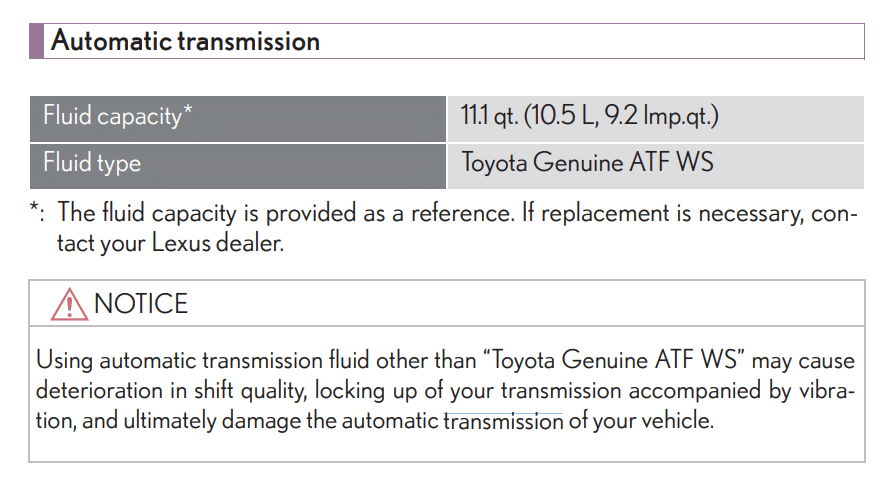The automotive world knows Lexus as a symbol of opulence, but with the IS F, Lexus pushed the boundaries even further. A vehicle birthed from the fusion of Lexus’s luxury DNA and spirited performance, the IS F stands out in the competitive luxury sports sedan segment.
Representing a perfect blend of aggressive aesthetics and a roaring V8 under the hood, the Lexus IS F, introduced in the late 2000s, quickly became a testament to the brand’s capability to craft both luxury and performance in one package.
But as with any high-caliber vehicle, ensuring that the IS F performs at its peak requires meticulous attention to its internals. This is where the significance of transmission fluid becomes paramount.

2008-2014 Lexus IS F Transmission Fluid Capacity And Transmission Fluid Type
When maintaining any vehicle, especially performance-driven models like the Lexus IS F, ensuring that you’re using the right quantity and type of transmission fluid is pivotal.
Here’s a breakdown of the fluid capacity and type for the 3rd Gen Lexus IS F:

3rd Gen (XE20) 2008-2010:
- Gearbox: 8-speed automatic (AA80E)
- Fluid Capacity:
- Total fill: Approximately 11.1 quarts (10.5 liters).
- Initial fill: Typically about 3.6 quarts (3.4 liters) when performing a standard fluid change.
- Fluid Type: Toyota ATF WS (World Standard)
3rd Gen (XE20) Facelift 2011-2014:
- Gearbox: 8-speed automatic (AA80E)
- Fluid Capacity:
- Total fill: Approximately 11.1 quarts (10.5 liters).
- Initial fill: Typically about 3.6 quarts (3.4 liters) when performing a standard fluid change.
- Fluid Type: Toyota ATF WS (World Standard)
For owners of these vehicles, always refer to the owner’s manual to confirm specifications.
Importance of Transmission Fluid in High-Performance Vehicles
Transmission fluid is more than just a lubricant; it’s the lifeblood that ensures the seamless operation of a vehicle’s transmission system. Especially in performance-driven models like the IS F, the choice and maintenance of transmission fluid play a crucial role.
It ensures that gear changes occur without hesitation, delivering the power of the engine to the wheels consistently. Moreover, in a vehicle designed to provide both luxury and performance, the right fluid ensures that the drive remains as smooth as it is exhilarating.
Transmission Fluid’s Contribution to Gear Changes
The role of transmission fluid in a vehicle, especially in performance models like the Lexus IS F, is multi-faceted. Its primary function is to lubricate the moving parts inside the transmission, reducing friction and wear.
However, it also serves as a medium for transmitting power from the engine to the drive wheels. In the IS F, rapid and smooth gear changes are crucial for maintaining its spirited performance.
The fluid facilitates these changes, ensuring that they happen seamlessly, allowing drivers to experience the vehicle’s raw power without interruptions.
Potential Risks of Using Incorrect or Low-Quality Fluid
Neglecting the quality and type of transmission fluid can have detrimental effects on a vehicle’s performance and longevity. Using incorrect or low-quality fluid can lead to:
- Increased Friction: Without the proper lubrication, parts within the transmission can wear out faster.
- Delayed or Harsh Gear Shifts: Inadequate fluid can cause hesitations or jarring transitions between gears.
- Overheating: The right fluid acts as a coolant. Low-quality or incorrect fluid might not dissipate heat effectively, leading to potential damage.
- Decreased Performance: Ultimately, all of the above factors can diminish the Lexus IS F’s famed performance, detracting from the driving experience.
In summary, for the Lexus IS F owner who cherishes both luxury and performance, understanding and maintaining the correct transmission fluid is more than just routine care – it’s a commitment to preserving the car’s essence.
Proper Procedures to Check and Replace Transmission Fluid
Maintaining your Lexus IS F’s transmission fluid is crucial for ensuring the longevity and optimal performance of the vehicle. Over time, transmission fluid can degrade due to heat and contamination, which can compromise its lubricating properties. Here’s a guide on how to properly check and replace the fluid:
Identifying Signs of Deteriorating Fluid
- Color Check: New transmission fluid is typically a bright red color and transparent. If the fluid turns brown or black, it might be an indication that it has started to deteriorate.
- Smell Test: Fresh transmission fluid has a mild odor. Burnt or off-putting smells can indicate degraded fluid or potential transmission issues.
- Viscosity Test: Rub the fluid between your index finger and thumb. It should feel smooth. If it feels gritty or has visible debris, it’s a sign of contamination.
- Shifting Issues: If your Lexus IS F hesitates during shifts or the shifts aren’t as smooth as before, it might be time to check the fluid.
A Step-by-Step Guide to Draining and Refilling
- Preparation: Ensure the vehicle is on a level surface. It’s recommended to have the engine warm to make draining easier as the fluid will be less viscous.
- Safety First: Always wear gloves and safety goggles. Ensure the vehicle is securely supported if you’re using ramps or jack stands.
- Drain the Fluid: Locate the transmission pan and place a collection pan underneath. Remove the drain plug, allowing the old fluid to empty into the collection pan.
- Replace the Filter: After draining, remove the transmission pan bolts and take off the pan. Replace the transmission filter which can accumulate debris over time.
- Clean the Pan: Before reattaching, clean the transmission pan thoroughly, removing any old fluid and debris. Ensure the magnet at the bottom of the pan, which collects metal shavings, is cleaned as well.
- Reattach the Pan: Apply a new gasket to ensure a tight seal and reattach the transmission pan. Tighten the bolts in a criss-cross pattern to ensure even pressure.
- Refill with New Fluid: Using a funnel, pour the new ATF WS fluid into the transmission dipstick tube. Be sure to fill the amount that was previously drained.
- Check Fluid Level: Start the engine and let it reach operating temperature. While keeping your foot on the brake, cycle through the gears, then place it back in ‘Park’. Check the fluid level using the dipstick, ensuring it’s within the ‘HOT’ marks.
- Monitor for Leaks: After replacing the fluid, monitor the area under the vehicle for a few days to ensure no leaks are present.
Remember, while this guide provides a general process, always refer to the Lexus IS F’s service manual for model-specific instructions.
FAQs
Addressing Popular Questions about Lexus IS F Transmission Fluid
1. How often should I change the transmission fluid in my Lexus IS F?
Typically, it’s recommended to change the transmission fluid every 60,000 to 100,000 miles. However, always refer to your owner’s manual or consult with a Lexus dealership for model-specific recommendations.
2. Can I use any type of transmission fluid for my Lexus IS F?
No, it’s vital to use the recommended type of transmission fluid for your specific model, usually ATF WS for the IS F. Using the wrong type can cause damage and diminish performance.
3. What happens if I overfill the transmission fluid?
Overfilling can lead to foaming, which decreases the lubricating properties of the fluid. This can result in erratic shifting, overheating, and potential transmission damage. If you suspect overfilling, it’s best to consult a mechanic.
4. How can I tell if my transmission fluid is low?
Symptoms of low transmission fluid include hard or delayed shifting, slipping gears, or a noticeable whining noise when accelerating. It’s essential to address low fluid levels promptly to avoid damage.
5. Is it necessary to change the transmission filter with the fluid?
While not always mandatory, it’s generally recommended to change the transmission filter when draining and refilling the fluid. This ensures optimal cleanliness and performance.
6. Can I mix old and new transmission fluid?
While it’s possible to top off with new fluid, a complete change is more beneficial. Mixing old and new fluid can dilute the effectiveness of the fresh fluid.
7. What’s the difference between a transmission fluid change and a transmission flush?
A fluid change involves draining the old fluid (around 40-50% gets removed) and then refilling. A transmission flush, on the other hand, uses a machine to replace nearly all of the old fluid with new fluid, offering a more comprehensive replacement.
8. If my transmission fluid is discolored, does it always indicate a need for a change?
While discoloration can be an indicator of aged fluid, it’s also essential to consider the fluid’s age, mileage, and any signs of transmission issues. It’s best to consult with a mechanic if unsure.
Conclusion
In the world of automotive excellence, the Lexus IS F stands as a testament to luxury seamlessly blended with performance. Like any precision instrument, the key to its continued prowess lies not just in its design, but in its maintenance. One aspect that remains non-negotiable is the condition and quality of its transmission fluid.
As we’ve seen, the transmission fluid plays a multifaceted role. It ensures smooth gear shifts, keeps the transmission cool, and acts as a lubricant, reducing wear and tear on moving parts. Yet, it’s often overlooked, dwarfed by the more evident aspects of car care like engine oil changes or tire rotations.
But, understanding its significance and ensuring it’s of the highest quality and in the right quantity is fundamental. A high-performance vehicle like the Lexus IS F, with its intricate engineering, demands nothing less than the best. The same fluid that facilitates those exhilarating accelerations and smooth cruises can, if neglected, turn into the vehicle’s Achilles heel.
In essence, routine checks and diligent maintenance of transmission fluid are not just chores. They’re investments. Investments into the continued luxury, performance, and longevity of the Lexus IS F. Every time you sit behind the wheel, let the responsive acceleration and seamless gear changes serve as reminders of the pivotal role that transmission fluid plays.
















